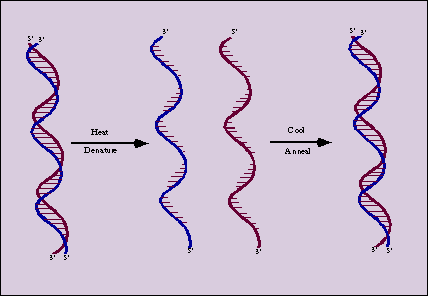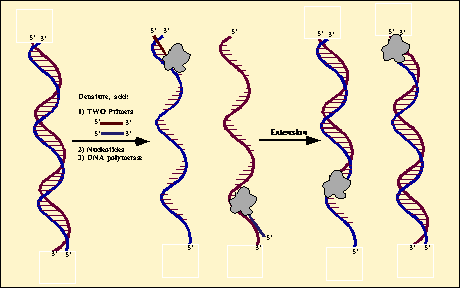DNA Denaturation, Annealing and Replication
On the last page, you saw the general structure of DNA, learning
what nucleotides look like, how they are formed into single- and double-stranded
chains, and how the nucleotides form weak bonds that help hold two chains together.
Now we'll learn why it is that the double-strandedness of DNA is so important.
You'll recall that, in the center of a double-stranded DNA molecule, the 'A' nucleotides
are weakly attracted to 'T' nucleotides, and 'G' is attracted to 'C'. This has some
critically important consequences. When two strands can pair like that, they MUST
have exactly opposite and complementary chemical structures. That means:
- If those two strands are separated, they still "recognize" their opposite
strand.
- If one strand is lost or damaged, it is possible to build it's exact duplicate just by
examining the remaining intact strand!
Here are some details:
|
If we heat up a tube of DNA dissolved in water, the energy of the heat can pull the two
strands of DNA apart (there's a critical temperature called the Tm
at which this happens). This process is called 'denaturation'; when we've 'denatured' the
DNA, we have heated it to separate the strands.
The two strands still have the same nucleotide sequences, however, so they
are still complementry. If we cool the tube again, then in the course of the normal,
random molecular motion they'll eventually bump into each other ... and stick tightly,
reforming double-stranded DNA. This process is called 'annealing' or 'hybridization',
and it is very specific;
only complementary strands will come together if it is done right. This process is used
in many crime labs to identify specific strands of DNA in a mixture.
|  |
|
Now, when we've denatured the two strands, there's something else we can do - replicate
the DNA. The key here is that any single-stranded piece of DNA can only hybridize
with another if their sequences are complementary. If we have just one strand, we
can actually build another strand to match it.
Here's how it's done, either in a test tube or in a live cell:
- The DNA strands are separated (for example, by heating them in a test tube).
- For each strand, we provide a primer, which is a short piece of DNA
that sticks to one end of the strand.
- An enzyme is added. This is a specific type of protein called a "DNA polymerase"
that can "read" the bases on one strand and can attach the complementary base to
the growing strand.
- The polymerase "walks" down the template strand and creates its exact
complement as it goes.
- The same thing happens to the other original strand.
When we started, we had one double-stranded piece of DNA. After polymerase is done,
we've got two identical pieces - exact copies of each other.
|
 |
[sorry - page under construction, as time permits.]
Return to the top of the DNA Primer
Go to the DNA Sequencing Core's Home Page

